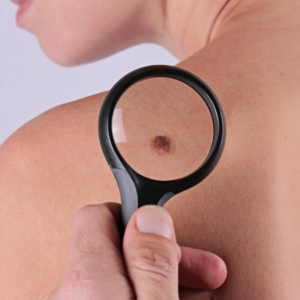Moles can indicate a potentially cancerous skin lesion, which is a cause for concern that should be diagnosed sooner than later. However, it’s true that a very small portion of moles we see at our Indiana dermatologist’s office are actually cancerous (thankfully). However, this doesn’t mean that you should ignore a suspicious mole that may need checking and potentially have a biopsy taken to determine if cancerous cells are present.
 On average, adults have anywhere from 10 to 40 moles, according to the American Academy of Dermatology. Some of these moles can experience changes that indicate the presence of melanoma, a severe form of skin cancer that can prove deadly. There are also other skin cancer types that can prove less deadly because they are less likely to metastasize (spread). These include basal cell carcinoma (BCC) and squamous cell carcinoma. Melanoma is less common than these cancer types. However, all lesion types should be removed due to the presence of cancerous cells.
On average, adults have anywhere from 10 to 40 moles, according to the American Academy of Dermatology. Some of these moles can experience changes that indicate the presence of melanoma, a severe form of skin cancer that can prove deadly. There are also other skin cancer types that can prove less deadly because they are less likely to metastasize (spread). These include basal cell carcinoma (BCC) and squamous cell carcinoma. Melanoma is less common than these cancer types. However, all lesion types should be removed due to the presence of cancerous cells.
Looking for Changes
Melanoma can cause moles that are normal in shape and size to change in appearance. If you experience the following symptoms, call our Indiana dermatologist’s office.
You notice changes in color.
Melanoma can cause a normally light-colored mole to turn black or deep brown. However, it is possible that a melanoma could be pink, tan and/or white.
The mole is on your trunk (if you are a man) or legs (if you are a woman).
Melanomas are more likely to appear in different areas depending on your gender. According to the American Cancer Society, women are more likely to get melanoma on their legs while men are more likely to have it on their trunks (chest and back). Both sexes can get melanoma on their faces and necks.
Moles can indicate a potentially cancerous skin lesion, which is a cause for concern that should be diagnosed sooner than later. However, it’s true that a very small portion of moles we see at our Indiana dermatologist’s office are actually cancerous (thankfully). However, this doesn’t mean that you should ignore a suspicious mole that may need checking and potentially have a biopsy taken to determine if cancerous cells are present.
On average, adults have anywhere from 10 to 40 moles, according to the American Academy of Dermatology. Some of these moles can experience changes that indicate the presence of melanoma, a severe form of skin cancer that can prove deadly. There are also other skin cancer types that can prove less deadly because they are less likely to metastasize (spread). These include basal cell carcinoma (BCC) and squamous cell carcinoma. Melanoma is less common than these cancer types. However, all lesion types should be removed due to the presence of cancerous cells.
Looking for Changes
Melanoma can cause moles that are normal in shape and size to change in appearance. If you experience the following symptoms, call our Indiana dermatologist’s office.
You notice changes in color.
Melanoma can cause a normally light-colored mole to turn black or deep brown. However, it is possible that a melanoma could be pink, tan and/or white.
The mole is on your trunk (if you are a man) or legs (if you are a woman).
Melanomas are more likely to appear in different areas depending on your gender. According to the American Cancer Society, women are more likely to get melanoma on their legs while men are more likely to have it on their trunks (chest and back). Both sexes can get melanoma on their faces and necks.
The mole has noticeably grown.
Moles that change in size and/or shape can be signs that a mole should be checked out at our Indiana dermatologist’s office. Most healthy moles tend to be smaller. When cancerous cells multiply quickly, the mole will likely grow much larger in size.
Stay Skin-Aware
One of the best steps you can take to aid in identification of potentially cancerous cells is to conduct a full-body assessment of your skin. You may even want to take a photo and/or video of moles you have, taken with a small ruler by each one so you can identify any changes in size, shape and/or color at future skin checks. According to a study in “The Journal of the National Cancer Institute,” skin self-exams have been shown to reduce the risks for deadly melanoma lesions by 63 percent.
You should also schedule a yearly full-body skin examination with your dermatologist. Doing this can help identify early signs of melanoma before cancerous cells can grow.
Back to Carolyn ….
Well that’s more than enough information for today!

